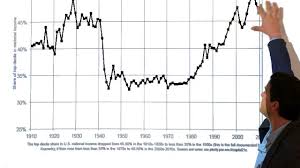Review “Thomas Piketty’s Capital in the twenty-first century: An introduction”

This book, billed as a short introduction to Piketty’s supersized bestseller on rising inequality, is itself an important step forward in the debate to understand rising inequality. The authors start by explaining why Piketty’s book was so popular with mainstream economists (he includes clear evidence of rising inequality but still supports free markets), then provide a balanced summary of the book’s strengths and weaknesses, and outline a fuller explanation of inequality which highlights the key policy options.
First things first; here’s their short version of Piketty’s 685-page epic. His central proposition is that since returns on capital are consistently higher than rates of economic growth, over time capital income and wealth will rise faster than waged income. Inequality and the political power of the rich will inevitably rise, excepting major crises (the great depression), wars (WW2) and social upheavals (revolution).
Piketty and others developed a large european dataset covering over 100 years to support this analysis, and his book included striking charts showing today’s inequality approaching levels last seen in the 1920s and still rising rapidly. So far so good, but using the ratio of two major economic outcomes (r > g, r the rate of return on capital, g economic growth) and asserting an inevitable trend doesn’t tell us anything about how and why this comes about, or how social struggle sometimes reverse the trend. Should we all sit around waiting for the next war to push politics back towards greater inequality, or perhaps plot another doomed revolution?
Before we come to these two reviewers’s suggested improvements though, Piketty deserves more credit for his sharp observations about the policy dilemnas of modern capitalism, and his advocacy for various taxes to redistribute capital incomes. Here’s the authors’s summary of Picketty:
“Due to weak economic growth, it will become increasingly difficult to ‘grow out of’ the debts accumulated in the last few years, that is to say, it will be increasingly difficult to contrast increasing debt with a corresponding growth in economic performance from which the debts can be serviced. The credit worthiness of states – that is, the trust of financiers in the financial solidity of governments – is thus also permanently endangered”.

“The growth of financial wealth has increased, along with the debts of states, businesses and households. This wealth – as credits, bonds and securities – represents claims worth billions upon yields that must be produced in the future. If these claims are not redeemed, a further financial crash threatens. There is too much capital, measured in terms of profitable possibilities for investment”.
So you can see why it was Piketty who triggered a wider public debate about inequality which had been rising for decades. His central conclusion from this trend analysis is that inequality is now an urgent problem for legitimacy and stability of capitalist ecomomies.
But “he regards the dominant economic system completely positively. The ideal condition he strives for is a properous capitalism characterised by economic growth. And he only criticises inequality to the extent that it could damage growth and the legitimacy of capitalism. He wants to protect capitalim from the poor – not the other way around”.
“According to Piketty, in the phase of the 1950s to the 1970s, the central bourgeois promise – that effort is rewarded – was redeemed. Modern societies were based upon the assumption of the equality of individuals. Material inequality could thus only be explained in terms of the inequality in the abilitites of individuals. In the future, however, says Piketty, it is not so much effort that will determine prosperity, but rather background and family, that is to say: inheritance. Western societies are moving towards a state of affairs in which those who receive their wealth in the cradle ‘call the shots’ “.
“The quintessence of Piketty’s analysis of inequality and its development is: with the increasing division of society, inheritances become increasingly important, and this is becoming a problem. With that – and only with that – inequality becomes injustice and thus a problem for Piketty, since inheritance is a way of transmitting wealth that is not mediated by the market, which he regards as scandalous. His demand is that only the market should decide the distribution of income. The market is for him the central entity of justice: market results are fair results”.
Still, credit where credit is due. His work “has led to a debate among social elites (encouraging) a split betwen an old ‘orthodoxy’ and those demanding a moderate turnaround”. We need this debate at all levels of society to have any prospect of new policy responses in future crises. And he argues that inequality is bad for economic growth, against the current orthodoxy of market efficiency.
On the policy side, Piketty advocates taxes on capital to rebalance the economy, and this is clearly the right response. But since he doesn’t question free capital markets he is forced to admit that in this environment this redistribution is likely to have limited impact: “attempts at taxing capital always run up against the same limit: the competition between states for investors”.
This is where Kaufmann and Stutzle add their own insights, highlighting some critical errors and omissions in Piketty’s work:
- accepts the market ideology of performance-linked inccome, where economic failures can be attributed to poor performance and further anti-labour reforms prescribed;
- accepts growth as the primary economic goal;
- omits the rise and power of financial capital;
- ignores the rising influence of housing wealth (capital) and debt in legitimising free markets among home owners while raising their vulnerability to crises;
- analysis is too eurocentric, ignoring alternative economic models in Asia and the role of colonialism in capital accumulation;
- omits the importance of protecting natural resources and equitably distributing resource income in developing nations;
- ignores the role of structural transformation and social struggles in moderating inequality.
In conclusion, the authors support a class analysis of power and inequality, arguing that social struggles are essential to wring concessions from the state, otherwise politics remains the politics of capital – and modest goals like a tax on wealth remain an illusion. Informed by this more realistic critique of modern capitalism, we are challenged to develop social movements which can provide realistic prospects of countering the rise in inequality which Piketty has so clearly identified.
“Thomas Piketty’s Capital in the twenty-first century: An introduction” by Sephan Kaufmann and Ingo Stutzle, is published by Verso 2017